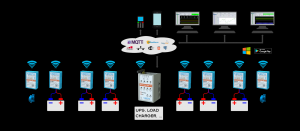Battery monitoring systems (BMS), the next generation's commodity
 Lead batteries that fail and interrupt a life-saving operation, thousands of families suddenly without power or an air traffic control tower whose communications and data lines fail while planes circulate in the sky. These are one by one examples of doomsday scenarios that we would rather avoid and the extent of which cannot be underestimated. Yet they are not unrealistic and have probably happened before.
Lead batteries that fail and interrupt a life-saving operation, thousands of families suddenly without power or an air traffic control tower whose communications and data lines fail while planes circulate in the sky. These are one by one examples of doomsday scenarios that we would rather avoid and the extent of which cannot be underestimated. Yet they are not unrealistic and have probably happened before.
Growing battery market
We increasingly rely on the continuous operation of batteries in our critical process flows. And as the future predicts, this will continue to increase. Just look at the high investments in green energy supply and the enormous expansion of the telecom industry. But sectors such as industrial automation, the medical industry and the transport sector are also increasingly dependent on batteries. This of course entails a great risk. Failure means out-of-business.
Batteries have a limited lifespan and charge/discharge cycles. There are many causes for a battery to fail. This may be due to age, high ambient temperature, deep discharge, overcharging, mechanical stress or simply poor quality. For most batteries, the change in value within one of these parameters is a clear indication of possible failure in the near future. Continuously monitoring these values therefore gives us valuable information about the risks of battery failure.
Just a cost maker or an efficient tool?
A battery monitoring system (BMS). You're probably thinking, another system, even more investments, even more data, and even more manpower to manage the system. And what does it actually achieve?
A BMS primarily ensures that the reliability of your battery system increases. It continuously measures the battery voltage, temperature, internal resistance, current as well as the number of discharge cycles and stores them in a database. This enables you to detect weaknesses and early failures and to perform preventive maintenance. In the event of significant deviations within one or more of these values, the system will inform you immediately. This way you retain control over your critical processes.
But a BMS also enables you to optimize the life cycle of your batteries through accurate analyzes of the measured values over time. This way you get the most out of your batteries and thus minimize the investment in battery replacements. In short, an efficient tool that not only protects your risks but also handles your investment smartly.
BMS 2.0
It is therefore not surprising that more and more companies are opting for a BMS. We also see a new generation of BMS emerging on the supply side that takes IoT as a starting point and focuses primarily on greater ease of use, less investment and less labor.
Wireless BMS systems
A wireless BMS is one of these new gadgets. From now on, individual batteries no longer have to be connected one by one to the central unit, but communication takes place via a license-free ISM band. Especially with extensive battery systems, you save considerable time and costs on installation and maintenance.
Easy to use software
The engine of every system is the software. BMS software is available in different forms. Some systems still work with downloadable software on a license basis. The new generation of BMS systems opts for license-free software via a web application. So no additional investment is required here and an unlimited number of users can log in from any PC.
Remote monitoring
By using a BMS system that works with an IoT protocol, data is automatically uploaded to the cloud via the central unit. This enables remote monitoring via a centralized platform. Your battery data is available around the clock, so you can take immediate action in the event of the slightest disturbance. This way you always have peace of mind.
When does a BMS become necessary?
There are a number of questions you need to answer before investing in a BMS.
- Is your application crucial to your daily business?
- Are the batteries a weak point of your application?
- What is the risk of possible damage caused by batteries?
- What are the costs of this damage?
Only once you have mapped this out can you compare whether your estimated risks and costs outweigh the investment in a BMS. Would you like more information and advice about BMS options? Then be sure to visit the Energy Storage event on February 13, 2020. There you can experience the operation of its BMS 2.0 called Battmaster® live at the A&C Solutions stand. For more information about Battmaster®, please visit www.battmaster.eu